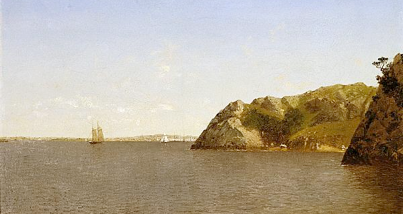
John Frederick Kensett, Newport, Rhode Island, 1872, o/c, 12 x 20”, Dallas Museum of Art, gift of Mrs. Eugene McDermott
Coastlines: Images of Land and Sea, Dallas Museum of Art, through August 22
Capitalizing on staycations, the DMA has used the quieter months of spring and summer to present Coastlines: Images of Land and Sea. As many an institution during these trying times, they have combed through their own collection rather than assume the cost of mounting a traveling one. This give locals an opportunity to see work that often spends, unfortunately, too much time in storage.
The Museum does this kind of show from time to time. Sometimes it is a great success and other times a real dud, as was the one a few years ago that had Van Gogh’s Sheaves of Wheat as its premise. Any painting or work on paper that had anything to do with wheat was pulled out, creating an uneven and not particularly interesting exhibition. Coastlines ran the possibility of suffering the same fate.
The Dallas Morning News ran a rather harsh review of Coastlines, which I do not think was completely deserved. While I can understand some of the criticism, mostly I think this exhibition, in its own way, is groundbreaking.
First the basics: it is a well-conceived, well-organized gathering of work that has been arranged thematically, beginning with the physical realities of the coast and ending with contemporary artists’ translation of what coasts evoke, with a few other topics in between. The work, for the most part, is good, with a few standouts and a couple of pieces that might make viewers say, “huh?”
The show’s curator, Heather McDonald, has done some very experimental (for museums) things with this for which she deserves a good deal of credit. For starters, this is truly an interdisciplinary exhibition. The music piped through the galleries is a soundscape created through the collaborative effort between faculty and graduate students in Arts & Technology program at the University of Texas at Dallas and their colleagues at France’s Université du Sud-Toulon-Var. Whether one likes it or not is irrelevant. The point is there is an attempt to break the traditional pattern of a staid museum going experience. This is a model with which the Museum has been experimenting for some time. There was a musical component to their exhibition All the World’s a Stage last year. But in that one, museum goers had to don earphones to hear the music. The current exhibition is much more of an all-encompassing sensory experience.
Then there are the labels. Gone are long, didactic info-panels. These list the specifics of the work and then present a literary evocation of the work.
The writer and artist need not have been at the same place at the same time. While Childe Hassam’s work is complemented by the words of Nathaniel Hawthorne, André Kertesz’s photography is supplemented by St. Augustine.
Is all this successful? That depends on the viewer. Personally, I enjoyed reading the labels. Often, the literary component made me look at the artwork longer. Other times it was its own distraction. But I do appreciate both it and the music’s ability to allow viewers to enter the artwork differently. And of the literary elements, there were beautiful quotes from such a wide range of writers and poets, from the aforementioned St. Augustine to Pablo Neruda.
Having said all that, what about the art? Well, sometimes there are reasons that art stays sequestered away for decades. There are definitely some gems in the show that should be seen more often. There were two beautiful watercolors by Raoul Dufy, one of which is playfully juxtaposed with an Eric Fischl work on paper in the bathers section of the exhibition. Jean Metzinger is magnificently represented by Le Port. Photographers are well represented. But, as can be the case in these sorts of gatherings of work, sometimes the theme runs thin, such as with the work of Willem DeKoonig.
In its publicity, the DMA suggests that if you can’t get to the beach this summer, get to the Museum instead. I would say it is definitely worth going through, especially if you include the Luc Tuymans exhibition currently on view as part of your itinerary. And as far as the interdisciplinary element goes, give the DMA credit for making the museum experience relevant for as broad a 21st century audience as possible.
